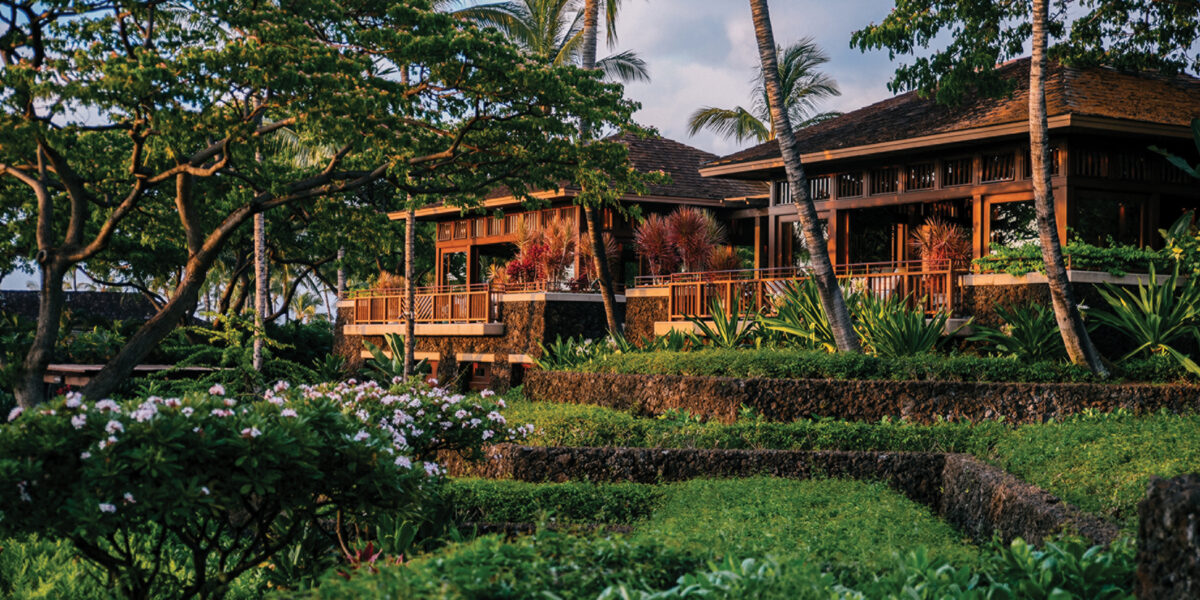
This Hawaiian Resort Is the Ultimate in Sustainable Luxury
How the storied Kona resort is upgrading its cultural and environmental practices.

The catamaran cuts up the Kona coast past striking black-sand beaches made by lava boulders that have been ground down by the waves over the past 150 years. Mauna Loa is in the distance on the port side. A pod of spinner dolphins glides toward us on the starboard side. The captain cuts the engines, and the dolphins escort us as we slowly float with the current. It’s a preposterously beautiful convergence of sea, epic views, sublime weather, and ocean wildlife. We’ve booked this boat ride through the Alaka’i Nalu ocean activities program at the Four Seasons Hualalai where we’re wrapping up the tail end of a vacation on the Kona coast, our first return trip in thirteen years. In the intervening years, the resort has upgraded its facilities with a resort-wide $100 million renovation, with an eye on sustainability and cultural preservation along with luxury. We’re here to, yes, relax, but also to experience firsthand how they’ve integrated these elements into the guest experience.

Four Seasons Resort Hualālai
At the heart of the cultural program is the Ka’ūpūlehu Cultural Center, a sizable facility located at a prime position in the center of the resort. Staffed with a team of professional musicians, dancers, and plant specialists, it offers round-the-clock programming and workshops on Hawaiian culture. Under the direction of lifelong educator Kaaiohelo McAfee-Torco, the center offers classes on Hawaiian language, star navigation, and plant identification alongside courses on lei making and other botanical crafts. On our visit, we make leis from flowers harvested from the garden of Michelle Kaulumāhiehie Amaral, a highly regarded hula soloist who is also a stellar lei maker. During the lesson, she shared some liberating wisdom as I struggled to keep my flowers strung straight: A lei’s beauty is in the eye of the beholder, and even the less florally skilled of us can make one by simply lashing a few loose blossoms to a folded ti leaf.

Four Seasons Resort Hualālai
The resort’s history of environmental stewardship dates back to the early 1990s, when restoration of onsite natural ponds commenced with the help of the resort’s director of natural resources, David Chai, who also helped lead a 10-year moratorium on fishing in the waters just off the resort. Among the array of pools at the resort, the most striking is King’s Pond, a veritable aquarium that is home to dozens of species of fish. Here children can safely snorkel with the fish and learn about the fragile ocean ecosystem from the staff marine biologist, who is part of a team that’s working with the Hawaii Department of Land and Natural Resources to catalog and count fish as part of the fishery rehabilitation program, putting resort staff on the front lines of ocean conservation.

Four Seasons Resort Hualālai
On land, the resort has planted over 50,000 indigenous koa trees, in partnership with the Hawaiian Legacy Reforestation Initiative, to help offset the carbon from stays in its rooms and private villas. And with 75 percent of the resort’s produce, meat, and fish sourced from local farmers and purveyors, and an on-property oyster farm, the resort’s restaurants are keeping money on the island and closing the locavore loop.
